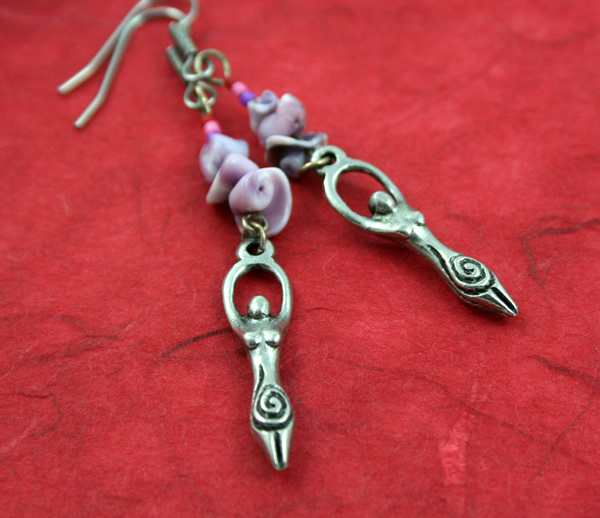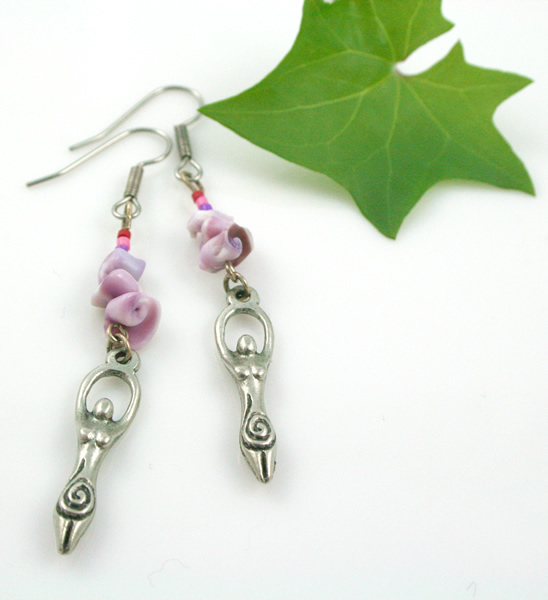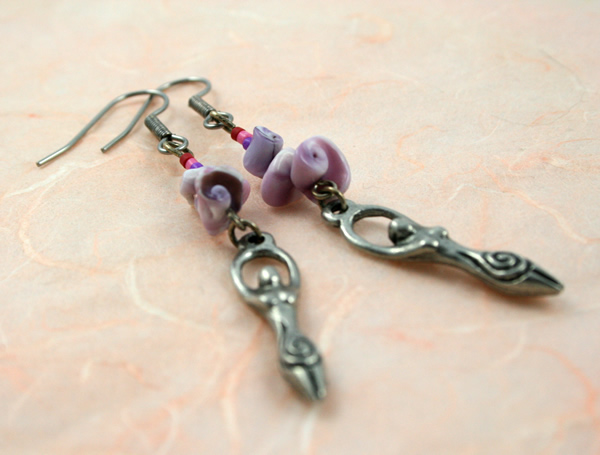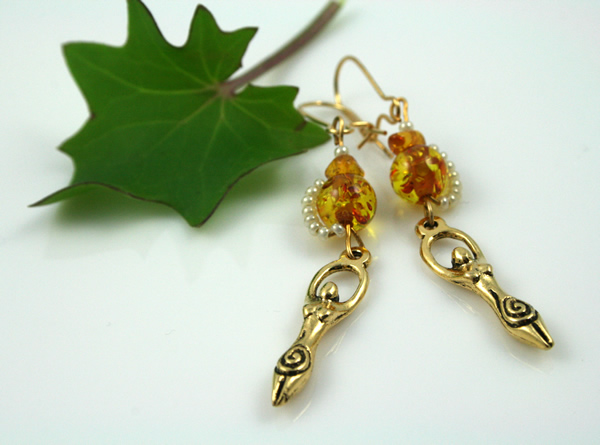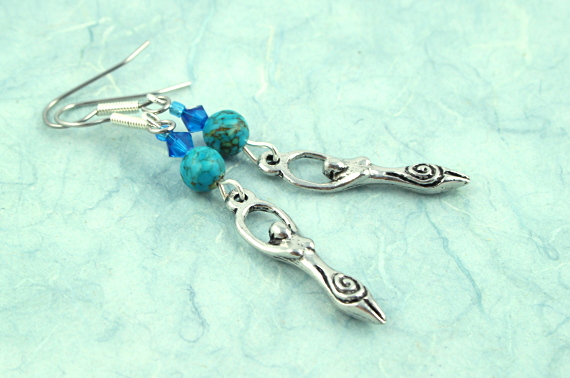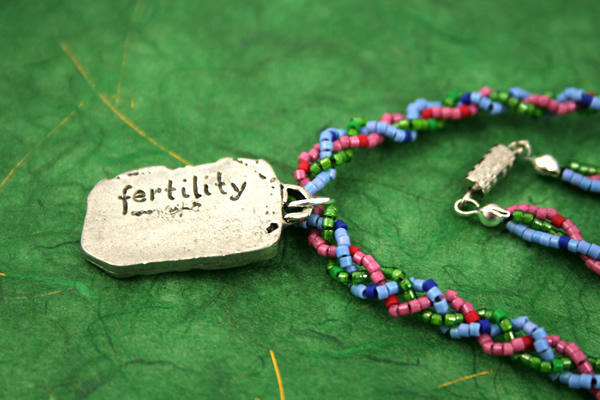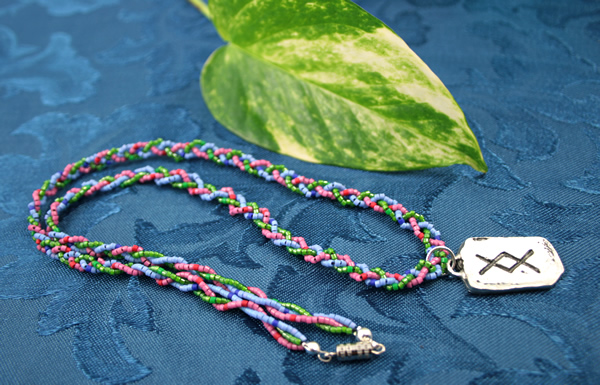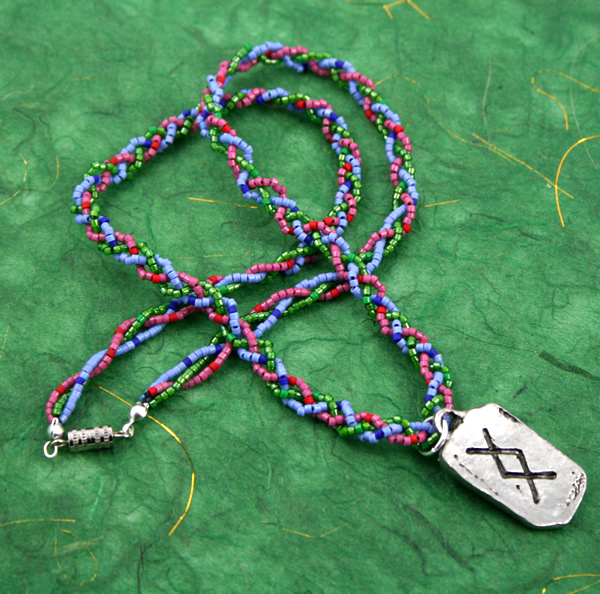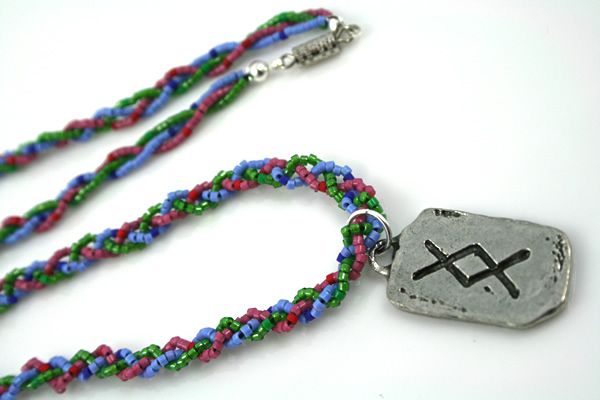On Etsy: https://www.etsy.com/listing/114973765/lilac-rose-birth-goddess-earrings
Tag: birth
Beading: Golden Amber Birth Goddess earrings
Beading: Birth Goddess turquoise earrings
Available for purchase on Etsy: https://www.etsy.com/listing/115242339/birth-goddess-turquoise-blue-earrings
Beading: Fertility braided necklace
Belly cast
 In August (about a month before my due date, and a bit more before Alaric was actually born), I travelled to Julie Keon’s studio in Cobden for a belly casting session. The result of this session was a white body cast from shoulders to top of the legs including the arms and hands, made with hospital grade plaster-gauze strips. The cast remained with Julie for a few weeks to be completed, strengthened and painted the shade of blue I have picked leaving the centre of the belly white for further decoration.
In August (about a month before my due date, and a bit more before Alaric was actually born), I travelled to Julie Keon’s studio in Cobden for a belly casting session. The result of this session was a white body cast from shoulders to top of the legs including the arms and hands, made with hospital grade plaster-gauze strips. The cast remained with Julie for a few weeks to be completed, strengthened and painted the shade of blue I have picked leaving the centre of the belly white for further decoration.
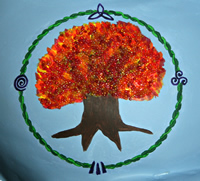 Julie had dropped the cast off about three weeks after Alaric’s birthday, and I had it set up in the basement. After collecting the required paints and beads, I’ve been working on the cast in 10-minute increments when the opportunity presented itself. Finally, I have completed decorating my belly cast last week and Julie has stopped by to finish it with a matte varnish.
Julie had dropped the cast off about three weeks after Alaric’s birthday, and I had it set up in the basement. After collecting the required paints and beads, I’ve been working on the cast in 10-minute increments when the opportunity presented itself. Finally, I have completed decorating my belly cast last week and Julie has stopped by to finish it with a matte varnish.
The decoration includes a Celtic knot circle with four Celtic signs, encircling the tree in fall colours to symbolize my autumn-born son.
The signs denote the following:
![]() Triquetra: there are many interpretations of this symbol,
Triquetra: there are many interpretations of this symbol,
the one chosen here is mother, father, child.
 Arwen: the first ray stands for male energy,
Arwen: the first ray stands for male energy,
the third one for female energy, and the middle one for balance,
this is a Celtic version of Yin-Yang.
![]() Triple spiral: symbolizes female power,
Triple spiral: symbolizes female power,
a combination of powers of maiden, mother, crone.
 Single spiral: birth and growth, evolution,
Single spiral: birth and growth, evolution,
surrender, release,
awareness of the one within the context of the whole.
The cast will serve as Alaric’s birth token and as a reminder of the ever-changing form of female body in childbirth – the memory of those changes already fading.
Book: My Mother Wears Combat Boots, by Jessica Mills
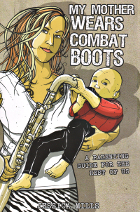
Title: My Mother Wears Combat Boots: A Parenting Guide for the Rest of Us
Author: Jessica Mills
Source: Midwifery Collective
ISBN: 9781904859727
Available online
Notes: A very thorough, well-researched, and informative book written by a punk musician and activist interested in raising her child in a way that promotes free thinking and discourages consumerism. This book is so full of useful advice and links to more information that making notes on it would result in me writing an article having the length of half the book itself. I found it so useful that I have decided to buy a copy of the book (I had borrowed the one I read).
The topics covered include medical birth interventions, newborn care, breast-feeding, co-sleeping, babywearing, cloth diapering, gender-coding, battling isolation, going back to work, exploring thrift stores for clothing, selecting first foods, weaning, setting up a “yes” environment for the child, organizing cooperative childcare and schooling, breaking the gender stereotypes of parental roles, TV exposure, touring with a child, cursing, discipline, disagreements with the child on fashion, safely marching in protests with children, setting up an art centre at home, critical analysis of marketing and media with a child, and getting away for a break without a child.
The book also contains several interviews of band members that toured with their children, and accounts of the author’s travels with her child. The resources section includes many links (in addition to those scattered throughout the book) and documentation samples for establishing cooperative daycare and school.
The New Mom’s Companion: Care for Yourself While You Care for Your Newborn
Ways to make pregnancy more comfortable
During pregnancy, one of the things you learn is to listen to and appreciate demands of your body. When a pregnant woman is hungry – she is starving, when she needs to sleep – she can fall into an exhausted sleep in most unlikely times and places, even if that is usually very uncharacteristic of her. Such basic urges become extreme, and if you ignore them they can wreck havoc with your body. So, try to sleep as much as your body demands and eat whenever you need to, don’t postpone your meals or rest.
Swimming or immersing yourself in water – helps against water retention, numbness, takes weight off the pelvis, can help the baby move into the head-down position, and just feels wonderful for all the lightness and buoyancy the water provides.
Walking helps with digestion and blood circulation. If your legs retain water (which occurs frequently in the third trimester) walking can help. I found walking to the beach (about 25 minutes), swimming (25 minutes to an hour), and walking back (another 25 minutes) to be a winning combination, but that was possible due to my close proximity to one of the Ottawa beaches and the later part of my pregnancy taking place during the summer. This routine can be modified to walk to a pool and back, assuming there is one near you.
Sleep – the first trimester is usually when the woman is the most tired. I used to collapse on the couch after work and sleep, although I normally can rarely nap during the day. The last trimester sometimes brings insomnia or restless sleep, due to all the discomforts of the pregnancy and worrying dreams that unfortunately replace all the sexually-charged dreams that are often present in the first and second trimesters. Babies also love to wait until you are lying down to start kicking, since you are not lulling them to sleep with motion. Sleep when you can where you can – you need all the energy to grow this new life.
Drink water – lots and lots of it. Drink before getting thirsty – thirst is a late sign of dehydration. Dehydration brings with it all kinds of nasty consequences: exhaustion, indigestion, and even contractions that can lead to premature labour. So drink lots of water.
Ginger candy – some people swear by them in that they help with morning sickness. I was not able to thoroughly test that since I managed to avoid this pregnancy bonus feature for the most part, but I found ginger candy generally helpful against nausea caused by motion sickness.
Bananas – wonderful fruit in general, containing fiber that helps with digestion and vitamin B6 that helps alleviate insomnia and fatigue. But one of the best things about bananas during pregnancy is that they also contain lots of potassium, which might help prevent leg cramps. During pregnancy leg cramps are a regular occurrence in many women, and short of “don’t cross your legs” and “don’t point your toes”, plus the usual suggestions of not sitting for a long period of time (great if you work at a desk), walking and taking a bath, no useful tips are offered to help with those. Another thing that helps with cramps is a calf stretch – sitting on the floor or lying down with your legs straight, flex your feet and push into the heels.
Update 2014: Later research shows that bananas have only half of potassium found in green vegetables (broccoli, avocados, asparagus, Brussels sprouts, and pumpkin), making the latter a better option, since bananas also have lots of sugar.
Cranberry juice – pure, 100% cranberry juice helps prevent urinary tract infections, which can spring up during pregnancy. It is hard to find pure cranberry juice in grocery stores in Ottawa – most of them sell cocktails or juice blends, both of which are full of sugar and the latter normally contains more apple juice than any other. The best pure cranberry juice I found is Just Juice – it needs to be diluted with water. It contains no added sugar and tends to be quite refreshing in summer.
Probiotics – good quality probiotics help digestion tremendously. Those sold in the drug stores, however, tend to be somewhat inferior to “professional-quality” probiotics (that include multiple species of microorganisms) which you can only get through health professionals or specialty health stores. I was recommended the Ther-Biotic Complete from Klaire Labs. Check with your health professional on their recommendation.
Papaya, pineapple, unbleached almonds, and not drinking water when eating are all good ways to help prevent heartburn. Papaya is also a good source of potassium. With the growing uterus pushing all the organs out of the way, which leaves little room for stomach, heartburn is a common issue during pregnancy. Eating smaller meals and sleeping with your head elevated also sometimes help.
The modified yoga Cat pose (the back has to be kept straight when not arched up) works wonders: it takes the weight of the uterus off the pelvis and the back. Used during pregnancy it can act as a way to relax and give yourself a chance to rest from the baby’s weight. This pose is also helpful in labour as pain relief as well as to allow the baby to shift out of the pelvis and using gravity acquire a different position that can be easier on the woman’s back.
Prenatal massage – helps with sore and tired muscles, leg cramps, back pain, and just feels wonderful. You would have to find a place that offers prenatal massage – they have special training in what is safe in pregnancy, as well as table inserts that allow you to lie on your belly during the massage. I have had several sessions throughout my pregnancy, including the one to fix my back when I managed to take a fall down the stairs in my first trimester, and I found them very helpful in alleviating various discomforts and aches.
Living in Canada, most of us don’t get enough vitamin D due to lack of sunlight. During pregnancy, the recommendation is 40 minutes of sunlight a day. A vitamin D supplement might also be helpful – consult with your health care provider.
Prenatal vitamins are highly recommended by every health practitioner and every book I have come across. In addition to taking folate (NOT folic acid) prior to pregnancy and during it to prevent neural tube defects in the developing fetus, some of the most crucial elements are included in prenatal vitamins, such as calcium (you are building the baby’s bones and if you don’t take in enough calcium it will be taken from your own bones) and iron (used in hemoglobin production and the formation of placenta). Many women exhibit iron deficiency during pregnancy, which can have serious consequences such as anemia.
Kegel exercises have been claimed to strengthen your pelvic floor muscles, which would have many beneficial effects: preparing your muscles for labour, postpartum return of pelvic tone, prevention of incontinence, and so on. Later investigation is showing that kegels are not effective for this purpose and are working the pelvic floor muscles in ways that tighten them, making them inflexible. Katy Bowman elaborates on biomechanics of the pelvic floor muscles and effective ways to work them. Deep regular squatting is a better way.
Eat lots of fruit – in addition to all the wonderful vitamins and minerals that you get from fruit, they also contain fiber which helps your digestive system.
Yogurt – helps prevent thrush (yeast infections) which sometimes spring up in pregnancy due to the sugar spike in vaginal flora. It can also be aggravated by synthetic or tight clothing, as well as by antibiotics (which you might be taking at some point during the pregnancy to treat some other condition). Wearing skirts (as opposed to pants) and cotton underwear (as opposed to nylon) help air circulation and can aid in keeping thrush under control.
Belly breathing is a technique where you breathe into your belly (not your chest) by flexing the diaphragm (not the rib cage). It helps to oxygenate and relax the body, which aids in relieving anxiety and stress.
In the last trimester some health practitioners recommend taking raspberry tea or a raspberry-leaf derived supplement (such as Rubus Idaeus) to tone the uterus and prepare it for labour. Do make sure you consult with your health practitioner before using this: some women find that their Braxton-Hicks contractions increase in frequency and intensity which might lead to preterm labour.
Witch hazel can help with perineum soreness or hemorrhoids. It can be used as part of a sitz bath (1/4 cup dissolved in warm water) or by soaking a sanitary pad. Before labour it is also recommended to soak a few maxi pads in witch hazel and freeze them, to use for postpartum perineal healing.
Calamine lotion can help with skin rashes that some women experience during pregnancy, due to uncomfortable clothing, heat, and carrying extra weight around.
Get a doula. A good doula is a source of all kinds of wonderful tips and tricks to make your pregnancy more comfortable. A doula also prepares you for labour by teaching you about pain relief techniques, labour progression, possible complications, and so on. A doula does not enforce any particular philosophy – you can have natural or medicated labour, at home or at a hospital, and the doula will be there to support you in whatever decisions you make. A labour doula is someone you get to know during your pregnancy and who would stay with you throughout your entire labour (as opposed to the doctor that would show up for 10 minutes only to deliver the baby, or a nurse that will stay only until the shift change and whose philosophy can significantly affect the progress of your labour). Postpartum doulas come to your place and can help solve breastfeeding problems, assist with baby care, and much more. To learn more about the roles and responsibilities of doulas, check out DONA International. I found my doula through Mothercraft – an organization in Ottawa that matches you with a doula and charges you on a sliding scale according to your income level, which makes it affordable for anyone, including low income families, to benefit from doula care.
Seriously look into midwifery care – it is much more personal, your appointments are longer, the care is based on informed choice (read: you have a say in what happens to you and your baby), and in Ontario you get 6 weeks of postpartum care, first week of which midwives can come to your home. Midwifery care is covered by provincial health insurance. Midwives in general have much better outcomes when it comes to labour induction and augmentation, Caesarean rates, and many other factors. Birth at home or a birth centre is ideal if you have no complications during pregnancy, but even in a hospital, midwives are a better choice for an uncomplicated delivery. If you are in Ontario and need more information on midwifery care, visit Consumers Supporting Midwifery Care.
Pregnancy and labour resources
I have read through quite a few books and articles on pregnancy, childbirth, breastfeeding, co-sleeping, babywearing, and so on. Not all of them I found helpful. Below is the list of those resources that provided me with the most useful information in the most usable form.
Books
 Ina May’s Guide to Childbirth, by Ina May Gaskin – the first part of the book is a collection of birth stories of women that have given birth on The Farm in Tennessee. The Farm is a community founded by Ina May, her husband, and several others in 1971, where one of the founding principles was giving women freedom to organize their own system of birth care. The midwives at The Farm have been consistently having lower intervention and Caesarean rates than the national average, and they have conducted single deliveries, twin deliveries, and various types of breech deliveries. The second part of the book covers the essentials of pregnancy and birth.
Ina May’s Guide to Childbirth, by Ina May Gaskin – the first part of the book is a collection of birth stories of women that have given birth on The Farm in Tennessee. The Farm is a community founded by Ina May, her husband, and several others in 1971, where one of the founding principles was giving women freedom to organize their own system of birth care. The midwives at The Farm have been consistently having lower intervention and Caesarean rates than the national average, and they have conducted single deliveries, twin deliveries, and various types of breech deliveries. The second part of the book covers the essentials of pregnancy and birth.
 Spiritual Midwifery, by Ina May Gaskin – this is an earlier book written by Ina May in 1975. It also starts with birth stories. The second part of the book covers female anatomy and physiology as it pertains to childbirth and has more in-depth notes on psychology, energy levels, birth complications, multiple deliveries, and required supplies.
Spiritual Midwifery, by Ina May Gaskin – this is an earlier book written by Ina May in 1975. It also starts with birth stories. The second part of the book covers female anatomy and physiology as it pertains to childbirth and has more in-depth notes on psychology, energy levels, birth complications, multiple deliveries, and required supplies.
 Birthing from Within, by Pam England and Rob Horowitz – this book explores attitudes towards labour, their expression in art, dealing with pain in labour, and covers tips for fathers and birth companions.
Birthing from Within, by Pam England and Rob Horowitz – this book explores attitudes towards labour, their expression in art, dealing with pain in labour, and covers tips for fathers and birth companions.
 Ina May’s Guide to Breastfeeding, by Ina May Gaskin – Ina May shares her experience on breastfeeding initiation, common issues and their correction, sleeping arrangements, breastfeeding multiples, shared nursing, and the need to recover the nursing culture in the Western society.
Ina May’s Guide to Breastfeeding, by Ina May Gaskin – Ina May shares her experience on breastfeeding initiation, common issues and their correction, sleeping arrangements, breastfeeding multiples, shared nursing, and the need to recover the nursing culture in the Western society.
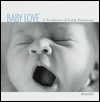 Baby Love: A Tradition of Calm Parenting, by Maud Bryt – a wonderfully calm and logical book by a Holland author, that makes common baby-caring tasks seem easy and stress-free. Here you can find tips on breastfeeding, diaper change, dressing the baby for a particular weather, introducing solids, sleeping and bathing routines, and swaddling the baby.
Baby Love: A Tradition of Calm Parenting, by Maud Bryt – a wonderfully calm and logical book by a Holland author, that makes common baby-caring tasks seem easy and stress-free. Here you can find tips on breastfeeding, diaper change, dressing the baby for a particular weather, introducing solids, sleeping and bathing routines, and swaddling the baby.
Films
 Relaxation, Rhythm, & Ritual: The 3 Rs of Childbirth, by Penny Simkin – this film consists of scenes of contractions from 10 separate women, each illustrating a way of creating their relaxation, rhythm, and ritual in labour.
Relaxation, Rhythm, & Ritual: The 3 Rs of Childbirth, by Penny Simkin – this film consists of scenes of contractions from 10 separate women, each illustrating a way of creating their relaxation, rhythm, and ritual in labour.
 The Business of Being Born, by Ricki Lake and Abby Epstein – this film takes a look at the sorry state of the obstetrical care in USA, specifically as it relates to childbirth. It covers the demonization of the midwives in the early 20th century, the move of the birth into the hospital, the big business approach to birth care, the currently-present domino effect of interventions and drugs administered at the hospitals, and the alternative – birth with the midwives, and specifically the home birth.
The Business of Being Born, by Ricki Lake and Abby Epstein – this film takes a look at the sorry state of the obstetrical care in USA, specifically as it relates to childbirth. It covers the demonization of the midwives in the early 20th century, the move of the birth into the hospital, the big business approach to birth care, the currently-present domino effect of interventions and drugs administered at the hospitals, and the alternative – birth with the midwives, and specifically the home birth.
 Comfort Measures for Childbirth, by Penny Simkin – this DVD illustrates many labour pain relief measures, as well as techniques to change a position of a baby when the progress of labour has slowed down. Each technique is explained in detail and illustrated by expectant couples. Penny Simkin also explains what happens to the pelvic bones when a particular position is used, showing how it would help the baby shift or turn.
Comfort Measures for Childbirth, by Penny Simkin – this DVD illustrates many labour pain relief measures, as well as techniques to change a position of a baby when the progress of labour has slowed down. Each technique is explained in detail and illustrated by expectant couples. Penny Simkin also explains what happens to the pelvic bones when a particular position is used, showing how it would help the baby shift or turn.
 Birth as We Know It, by Elena Tonetti-Vladimirova – the author was one of the creators of a Black Sea birth camp in Russia in 1980s, where women came a few months before pregnancy and learned relaxation techniques. The film includes footage of women giving birth in the Black Sea, as well as having water birth at home. It provides an insight into the power of the female body and conscious childbirth. In addition to the breech, twin, home birth, and water birth, the film includes a self-assisted birth by a midwife Tanya Sargunas.
Birth as We Know It, by Elena Tonetti-Vladimirova – the author was one of the creators of a Black Sea birth camp in Russia in 1980s, where women came a few months before pregnancy and learned relaxation techniques. The film includes footage of women giving birth in the Black Sea, as well as having water birth at home. It provides an insight into the power of the female body and conscious childbirth. In addition to the breech, twin, home birth, and water birth, the film includes a self-assisted birth by a midwife Tanya Sargunas.
Hospital birth essentials
Below is a list for the hospital birth that I have compiled from books (see Pregnancy and labour resources), as well as from the information provided by my midwife, my doula, and the prenatal classes. This list will differ depending on your location. For instance, in Canada you will not be allowed to take the baby home from the hospital if you do not have a safe infant car seat (even if you live across the road from the hospital and are walking home). Check with your hospital for any specific requirements they have. If you find the list somewhat overwhelming, there are places from which you can order hospital birth kits – it might actually be cheaper than trying to track down each item on its own. In Canada, Mama Goddess Birth Shop carries a good selection of birth kits and related supplies.
Hospital birth essentials
- Car seat which you know how to use. The seat should be left in the car until you are ready to leave the hospital.
- Your health card.
- Parking money and change for cafeteria.
- Extra clothing and blankets for the baby, depending on the season.
- Car with a full gas tank (if you are driving).
- Directions to the hospital (preferably several variations to avoid construction or traffic jams).
- Comfortable clothes for the hospital stay and for the way home (remember that you might still need clothing you wore when you were about 6 months pregnant).
- Knee-high comfortable socks – feet do get cold in labour. Bring more socks as they might get stained during labour.
- Slippers or slip-on shoes – you do not want to walk on the hospital floors barefoot.
- Lip balm – your lips will get very dry in labour.
- Lots of underwear (you’ll probably go through 1 or 2 during labour and will probably need 1 or 2 after that).
- Night dress or t-shirt to serve as one.
- Nursing bra – you most likely will not need nursing pads yet.
- Sanitary pads (maxi pads), large size, to soak up postpartum bleeding.
- Toiletries and shampoo for the shower.
- Phone numbers for those people you wish to notify of the birth.
- Vitamins/supplements/medication you need.
- Hair ties/clips and a hair brush.
- Bottle of water for the ride to the hospital.
- Energizing drinks: fruit juices, Gatorade, Emergen-C, etc.
- Fresh fruit, light snacks for the mother.
- Extra cutlery (hospitals sometimes run out).
- Food for the partner (sandwiches, crackers, cheese).
- Pen (there will be documents to sign and it’s convenient not to be searching for one for ages).
- Lots of pillows (hospital pillows are notorious for being too small, too hard, and too few). Put them into non-white pillow cases to distinguish them from the hospital ones.
- Receiving blankets for the baby (you’ll probably need 2) and 1 outfit for the baby (undershirt and sleeper).
- Warm baby blanket, hat, diapers.
- Camera with a spare battery.
- Music player with headphones or mini-speakers if allowed and desired.
- Any birth art you might want to focus on during labour.
- Bathing shorts for the partner (if he joins you in water comfort measures).
Home birth essentials
Below is a list for the home birth that I have compiled from books (see Pregnancy and labour resources), as well as from the information provided by my midwife, my doula, and the prenatal classes. This list will differ depending on your location and any specific requirements of your midwife (check with them for what their list is). If you find the list somewhat overwhelming, there are places from which you can order home birth kits – it might actually be cheaper than trying to track down each item on its own. In Canada, Mama Goddess Birth Shop carries a good selection of birth kits and related supplies.
Home birth essentials
- Old linens that you do not mind staining. Bed sheets – 2, towels – 4-6, washcloths to be used as perineum compresses – 10 small ones (10x10cm is good). For the washcloths, you can buy a towel and cut it up into smaller pieces. No need to get new sheets and towels – ask your friends to donate some old ones or pick some up at a second-hand store.
- You can get a few inexpensive yoga mats to provide for extra cushioning on the floor. Cover the yoga mats with a plastic sheet and a bed sheet.
- Plastic sheet or two to protect your bed and/or floor.
- Lip balm – your lips will get very dry in labour.
- Hot water bottle or heating pad.
- Container for the placenta (a large ice cream or yogurt container is good). Placenta makes for a good fertilizer, hence the tradition of planting a tree and burying the placenta under it.
- Large garbage bags (1 for garbage and 1 for laundry).
- Cotton underpads, so the bed is kept clean.
- Sanitary pads (maxi pads), large size, to soak up postpartum bleeding. To help with perineum healing, soak a few of the pads in witch hazel and freeze them before labour. They will help reduce perineal swelling postpartum.
- Flashlight for the midwife if the lighting is dim.
- Small hand mirror for the midwife if you are in a position making it difficult for them to see the baby’s head.
- Bowl that will contain water for compresses.
- Kleenex, toilet paper, or paper towels.
- Thermometer.
- Squirt bottle (also known as perineum/peri bottle) for rinsing the perineum after the labour.
- Knee-high comfortable socks – feet do get cold in labour.
- Sitz bath and perineal herbs to aid in perineal healing postpartum.
- Lots of pillows.
- Receiving blankets for the baby (warmed up in the dryer before delivery if possible).
- Outfit for the baby – a sleeper and an undershirt.
- Warm baby blanket, hat, diapers. Even if you are set on using cloth diapers, get 1 pack of disposables for the first few days. Meconium is dark and hard to get out of cloth.
- Energizing drinks: fruit juices, Gatorade, Emergen-C, etc.
- Bendable straws.
- Fresh fruit, light snacks for the mother.
- Food for the birthing group (bagels + cream cheese, soup, coffee).
- Oil for massage.
- Camera with a spare battery.
- Music, candles, aromatherapy if desired.
- Any birth art you might want to focus on during labour.
Natural labour tips
All the tips below are meant for a pregnancy without complications and for a natural birth (i.e., birth without drugs or interventions) that would take place either at home or at the hospital. By no means should these tips replace the advice of your midwife or doctor. These tips have been gathered from the books on labour and delivery (see Pregnancy and labour resources), as well as from the prenatal classes and the information given to me by my midwife and my doula. Use at your own risk.
Stages of labour
Early labour (may last 12 hours or more, dilation 0-3cm, contractions lasting 30-60 seconds being 5-20 minutes apart, possibly water breaking, possibly loss of the mucus plug) is best ignored. Go about your day as much as you can. Work on a labour project (do something that keeps you moving, in touch with your everyday life and mentally engaged: bake a cake, write letters or postcards, wash/fold clothes, clean, etc.) If the labour starts in the evening, it is best to halt it. Getting into a warm bath (if your water have not broken) and having a glass of wine can help stop contractions. This might give you a chance to sleep and gather up the strength for the inevitable resumption of labour that is to follow. It also gives your birthing group a chance to rest up before the labour marathon. Many hospitals will send you home if you arrive there in early labour.
Active labour (may last 6 hours or more, dilation 3-7cm, stronger contractions lasting 45-60 seconds being 2-5 minutes apart, possible increase in bloody show, possible increase in pressure in the back) is when it starts to get real. Various pain relief measures can be used: massage, putting pressure on the tail bone in case of back labour, using the physio ball to lean on, slow-dancing or hanging from a partner, finding a rhythm that works for the woman. The warm bath or shower is better not to be used before the dilation reaches 6cm. Many women are ready for an epidural at this point, and water might help them get over the need for it and allow to continue drug-free. It is said that it is about as hard to get to 6cm dilation as it is to get to 10cm, so once the woman gets to 6cm it will not get progressively more painful, but will stay approximately at the same level.
Transition phase (may last from a few minutes to a few hours, dilation 7-10cm, much stronger contractions lasting 60-90 seconds being 2-3 minutes apart, possible increase in bloody show, possible strong pressure on back and rectum, possible vomiting, possible urge to bear down) is the intense part of labour before delivery. Very intense contractions, keeping a rhythm it seems is the only help here.
Pushing stage (may last a few minutes to more than 1 hour, dilation 10cm, slightly less painful contractions lasting 45-90 seconds being 3-5 minutes apart) might bring with it an overwhelming urge to push. This is when the baby’s head is crowning and the baby is eventually born.
Tips for active labour, transition, and pushing stages:
- Labour in private or be comfortable with those in attendance. Women have been known to not only stop dilating and completely halting labour, but also reversing the dilation, if they feel uncomfortable with the atmosphere in the room. This stems from the adrenaline-producing response to a frightening stimulus in nature, where a female of the species must flee or fight before the labour can continue.
- Laugh and relax your facial muscles, mouth, and jaw. If your jaw muscles are tight, chances are your cervix is not opening up either.
- Use nipple stimulation to produce oxytocin – the hormone that helps the uterus contract.
- Try hydrotherapy: take a warm bath (unless your water broke) or shower, preferably after dilating to 6 centimetres.
- Walk, dance, change positions – move around during labour: the movements help your baby move down. Move your hips, it helps the labour progress.
- Concentrate on an opening mantra (you can make one up) or a piece of birth art – it will help you open up.
- Relax pelvic muscles – the baby is coming out one way or another. Relax your bottom to help the process along.
- Breathe slowly and deeply – this is the basis of many yoga teachings: deep breathing helps relax the muscles.
- Speak loving words – Ina May categorically states that she has never seen anyone’s cervix remain tight when they spoke words of love to those around them.
- Use the “horse lips” technique – relax your lips, blow a good amount of air through them while flapping them like a horse would. This relaxes the throat and jaw muscles and with them the cervix and the perineum. If it makes you laugh – so much the better, since laughing aids in muscle relaxation.
- Sit on a toilet, a birth stool, edge of a bed, squat. Move in ways that feel natural to you – the hip movements help the baby move down.
- Let gravity do the work – use upright positions. The “classical” Western childbirth position with a woman on her back with her legs up is possibly the most illogical one: not only does the pelvis get narrower in this position, but the baby has to be moving horizontally and then upwards. The only reason for this position is to allow doctors easier access to the patient, not to make birth easier for the woman.
- Drink a lot to stay hydrated (take a sip after every contraction – make your partner bring the straw to your lips), urinate every hour (this will ensure that at least once an hour your pelvic muscles relax which will help the progress of labour).
- Explore touch and massage: pressure on the tail bone or on the lower back, hand and foot massage, thigh and leg massage.
- Invoke goose bumps on the mother – this manoeuvre causes a release of endorphins.
- Explore being shaken by others to speed up a prolonged labour – this can be the rhythmic shaking of the woman’s thighs or a Chinese approach called chung when two or three people vigorously shake the mother all over.
- Pant when pushing to reduce probability of tears, push only when you have an urge to push.
- Stimulate clitoris as baby emerges – this increases vaginal engorgement and might help prevent lacerations.
- Make low register noises, such as moans, – the vibration will be reflected in the lower part of your body.
- Use the relaxation, rhythm, and ritual technique described by Penny Simkin: she found that women that cope well in labour exhibit the same three basic traits: they are able to relax between or during contractions, they use rhythm to get through the contractions, and they create their own ritual by following the rhythm they have chosen.
And remember, labour is hard, it is painful, and you can do it.
Birth Zen
I have three children, all born at home in a waterbirth, and I am a proponent of calm pregnancy, peaceful birth, breastfeeding, connected parenting, and informed choice in all things. I have contributed to several birth-related initiatives in Ottawa, including Mothers of Change, Consumers Supporting Midwifery Care, CHOICE! Birth and Baby film festival, and Holistic Birth Directory – a growing repository of holistic birth practitioners. Below are my notes on natural approach to pregnancy, childbirth, midwifery, breastfeeding, and childcare.






